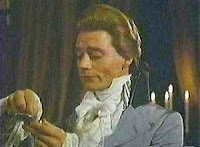 The title of today's musing comes from a Christmas song written by Steve Allen and performed by Louie Armstrong in 1953. I had planned for the previous blog to be my last for 2018. However, that took a dark turn which was mentioned by several of my blog-benefactors. That and an interesting winter solstice email from Smithsonian.com were impetus for today's blog.
The title of today's musing comes from a Christmas song written by Steve Allen and performed by Louie Armstrong in 1953. I had planned for the previous blog to be my last for 2018. However, that took a dark turn which was mentioned by several of my blog-benefactors. That and an interesting winter solstice email from Smithsonian.com were impetus for today's blog.Around the 13th century, monks created a festive, holiday drink
involving eggs, sugar, milk and sherry that we call Egg Nog. The origin of the name is unsure. Some trace it to an little known Old English word meaning a strong beer. Others reference an Old Germanic/Norse word for a drinking cup. The beverage was de rigueur for the wealthy as the ingredients were costly.
In colonial America, all of the items, except the sherry, were more available and thus less expensive. One commodity plentiful and cheap in the colonies was rum. That replaced sherry. Egg Nog became popular. George Washington created his own recipe. It shows the preference for strong drink among the early Americans: "sugar, milk, cream, eggs—add one pint of brandy, half a pint of rye, half a pint of rum and a quarter pint of sherry to the mix. In talking to a co-worker who was raised in Richmond, Egg Nog isn't Egg Nog without bourbon. I prefer brandy, or rum, but bourbon works. I'm sure it's a southern thing.

Walking through the neighborhood this time of year provides an extravaganza for the eyes. The lights and displays give a glorious glow to the night. What would the holidays be without Christmas lights? As the story goes, walking home one night during the Christmas season, starlight reflecting off the evergreens filled Martin Luther with the glory of the season. It was customary for Germans to clip the top off of an evergreen tree and put it on a table in the house. When Luther got home, he attached candles to his tree and the Christmas light was born.
Albert, the Prince Consort to Queen Victoria, brought the Christmas tree tradition to England from Germany. It caught on with the populace. Of course lit candles on a flammable tree raised some safety issues. Most homes had buckets of water around the tree. Beauty does have a price.

In 1892, Edward Johnson, a partner of Thomas Edison, took the incandescent light and invented the first electric Christmas lights. By 1895, they adorned the White House tree. Those early lights got as hot as candles making fire a still-present hazard. Over the years inventive minds fine-tuned Christmas lights making them safer and more brilliant. Now you can get lights that react and blink to the rhythm of your holiday music.
So this Christmas season, enjoy the libation of your choice, feast your eyes on the decorations and lights, stuff your bellies with delicious food and fill your soul with tidings of comfort and joy. All my love and holiday best wishes- as ever - BB
"Christmas is a season for kindling the fire for hospitality in the hall, the genial flame of charity in the heart.” - Washington Irving
























